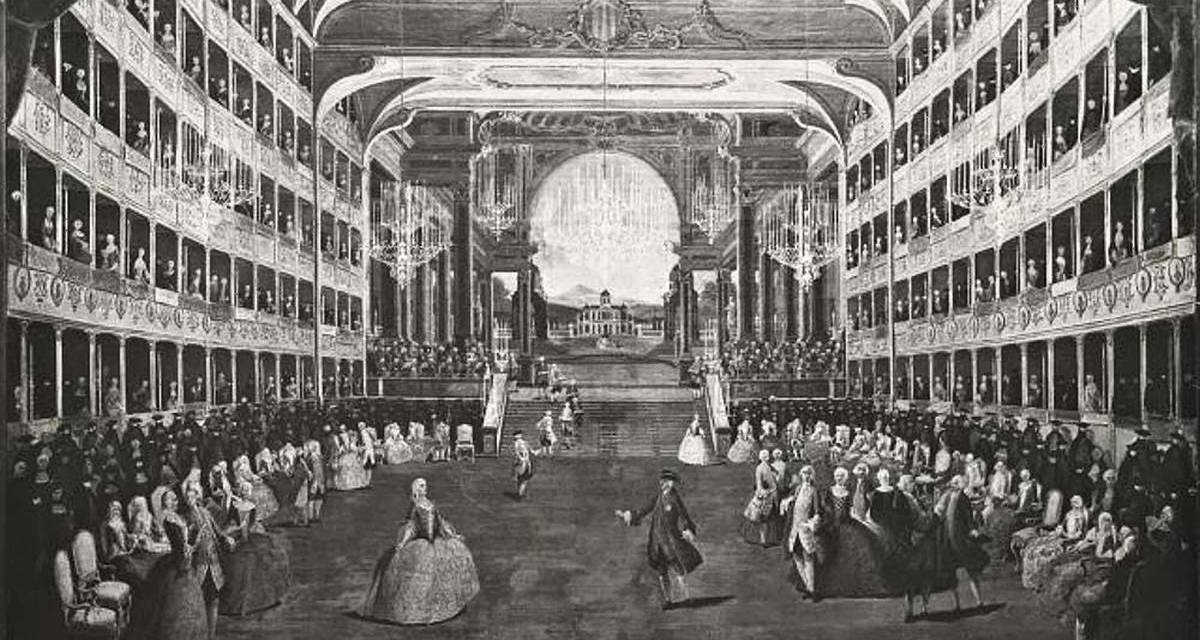The very first opera – Dafne by Jacopo Peri – was performed in the grand house of its librettist, Ottavio Rinuccini, in 1598 during the Venice carnival. At the time, operas and the musical entertainments that preceded them were staged by the aristocracy, nobility or rich merchants in order to impress visiting dignitaries. Such events were not meant for the general public.
Courtly theatres were housed in the grand homes of the wealthy. In such spaces there was little distinction between the stage and auditorium, and in fact at masques the audience would often join in with the actors. What changed all this was a motivation for profit.
The very first venues for spoken-word plays began appearing in the 1580s in Venice. These were open to a paying public, generally owned by noble families or wealthy entrepreneurs and the idea was to make money.
This led to a change in design, as rather than ostentation and a desire to impress, the overriding consideration was the need to accommodate as many customers as possible. Tiers of galleries were introduced, along with stalls and areas with benches. The orchestra was moved to the space just in front of the stage; it was sunk and became known as the pit.
These changes meant that many more people could attend performances, taking opera out of the hands of a privileged few and making it accessible to many more people – so long as they could afford the price of the ticket. It also created a new division between audience and performers and gave us the architectural style of opera houses and theatres that we’re familiar with today, with a raised stage at the front of the auditorium, the orchestra in the pit and then seating arranged around this in a horseshoe shape.
The first public opera house designed in this way was Venice’s Teatro San Cassiano, which opened in 1637. Owned by the Tron family, it took its name from the neighbourhood in which it was located, the parish of San Cassiano near the Rialto. The Trons were a prominent Venetian noble family. The new theatre was considered public as it was directed by a general manager – known as an impressario – as a commercial enterprise.
The first operas performed at San Cassiano were L’Andromeda in 1637 and La Maga Fulminata in 1638. These were composed by Roman Baroque composer Francesco Manelli with librettos by Benedetto Ferrari, another Roman. The music for both has been lost. Ferrari and company stayed with the theatre until 1639, when it was taken over by entrepreneur Francesco Caletti-Bruni, who composed most of the operas performed there between 1639 and 1645. Impresario Marco Faustini managed the Teatro San Cassiano from 1657 to 1660.
By the end of the 17th century, another 10 opera houses had opened in Venice and the city became the opera capital of the world. By this time a total of 37 operas had premiered at Teatro San Cassiano, but the theatre was being surpassed by these newer venues and the number of performances declined.
Sadly, San Cassiano is no longer around. The final performances took place in 1807 and in 1812 it was demolished, largely due to recurring fires. But could this phoenix arise from the ashes? British tax consultant and opera lover Paul Atkins has launched a project to rebuild the theatre as faithfully as modern scholarship and traditional craftsmanship will allow. Once opened, the new Teatro San Cassiano will stage, promote and research Baroque opera. You can find out more about this exciting project here.
Image
Opening in 1637, the Teatro San Cassiano was the world’s first dedicated opera house (https://commons.wikimedia.org).

